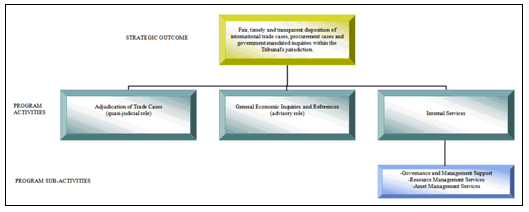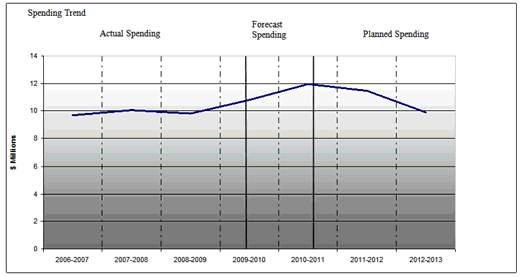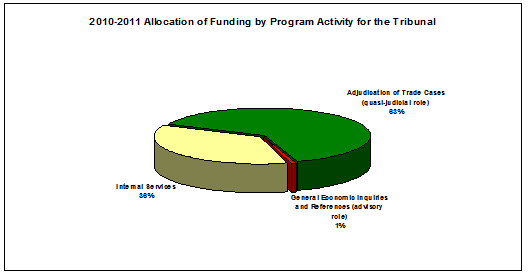Common menu bar links
Breadcrumb Trail
ARCHIVED - Canadian International Trade Tribunal
 This page has been archived.
This page has been archived.
Archived Content
Information identified as archived on the Web is for reference, research or recordkeeping purposes. It has not been altered or updated after the date of archiving. Web pages that are archived on the Web are not subject to the Government of Canada Web Standards. As per the Communications Policy of the Government of Canada, you can request alternate formats on the "Contact Us" page.
I am pleased to present the 2010-2011 Report on Plans and Priorities (RPP) for the Canadian International Trade Tribunal (the Tribunal).
The Tribunal's mandate is to provide the fair, transparent, timely and effective disposition of international trade cases, government procurement reviews and other matters in various areas of the Tribunal's jurisdiction. The Tribunal inquires into trade-related complaints (i.e. dumping, subsidizing and safeguards) and complaints regarding federal government procurement. The Tribunal hears appeals from decisions of the Minister of National Revenue and the Canada Border Services Agency (CBSA) under the Excise Tax Act and the Customs Act respectively. In its advisory role, the Tribunal undertakes general economic inquiries and tariff references for the Minister of Finance or the Governor in Council. In so doing, the Tribunal contributes to Canada's competitiveness and a fair and secure marketplace.
With the economic recovery now underway, the Tribunal is preparing itself for a busy year ahead. Trade remedies cases are expected to increase, as domestic producers and importers position themselves to participate in the growing economy. As well, procurement cases should continue their upward trend. This trend is influenced both by the continued importance of government procurement to the private sector during this period of economic recovery and by an increased awareness of the Tribunal's procurement work. The government's emphasis on accountability, including the work of the Procurement Ombudsman, has increased this awareness. The appeal caseload will also be heavy, as the Tribunal addresses a backlog of cases carried forward from 2009-2010. The Tribunal has received supplementary funding through to fiscal year 2011-2012 that will enable it to manage effectively this increase in caseload.
The Tribunal's main priority for 2010-2011 continues to be the fair, timely and effective disposition of cases, and the supporting priority remains that of continuous improvement, as the Tribunal targets initiatives under three broad categories: investment in its people, sound management practices and improved service delivery.
Under the category of investment in its people, the Tribunal's priorities for 2010-2011 are recruitment and staffing, professional development, inclusiveness in its workforce and staff recognition. Under sound management practices, the Tribunal will continue to focus on effective planning and rigorous management practices. Of particular note, the Tribunal will initiate a review of its rules of procedure in order to streamline proceedings before the Tribunal and to reduce the paper burden imposed on parties. Under improved service delivery, the Tribunal's priorities are to increase the efficiency and reliability of its information technology (IT) infrastructure, improve its information management function and provide parties with electronic access to its case files. Through these initiatives, the Tribunal will contribute to advancing government priorities by enhancing its services to Canadians, improving its accountability and ensuring the transparency of its operations.
The original version was signed by:
André F. Scott
Chairperson
Raison d'être
The Tribunal provides Canadian and international businesses with access to fair, transparent and timely processes for the investigation of trade remedies cases and complaints concerning federal government procurement and for the adjudication of appeals on customs and excise matters. At the request of the Government, the Tribunal provides advice in tariff, trade, commercial and economic matters.
Responsibilities
The Tribunal was established in December 1988 under the Canadian International Trade Tribunal Act (CITT Act). It acts as an independent, investigative and quasi-judicial decision-making body that reports to Parliament through the Minister of Finance. The Tribunal also derives authority from the Special Import Measures Act (SIMA), the Customs Act and the Excise Tax Act. The Tribunal's office is located in Ottawa, Ontario.
Under SIMA, the Tribunal conducts inquiries into whether dumped and/or subsidized imports have injured Canadian manufacturers. Pursuant to the Customs Act, the Excise Tax Act and SIMA, the Tribunal is empowered to deal with appeals from decisions of the Minister of National Revenue and the CBSA on various excise and customs matters. The Tribunal has also been designated as the bid challenge authority on federal government procurement matters under the Agreement on Internal Trade, the North American Free Trade Agreement (NAFTA), the World Trade Organization (WTO) Agreement on Government Procurement and the Canada-Chile Free Trade Agreement. Under the CITT Act, the Tribunal inquires into and provides advice on such economic, trade, commercial and tariff issues as are referred to the Tribunal by the Governor in Council or the Minister of Finance. It also undertakes safeguard inquiries under the CITT Act and is empowered, on complaint by an interested party or as directed by the Government, to carry out inquiries into rapid increases in imports (including through special procedures for imports specifically from the People's Republic of China), and to formulate recommendations to the Government for dealing with such imports.
Strategic Outcome and Program Activity Architecture
The chart bellow illustrates the Tribunal's complete framework of program activities and program sub-activities.

Planning Summary
| 2010-2011 | 2011-2012 | 2012-2013 |
|---|---|---|
| 11,941 | 11,441 | 9,901 |
| 2010-2011 | 2011-2012 | 2012-2013 |
|---|---|---|
| 96 | 91 | 77 |
| Performance Indicators | Targets |
|---|---|
| Tribunal decisions overturned by the Federal Court of Appeal or international appeal bodies | Less than 2 percent of all decisions rendered are overturned by the Federal Court of Appeal or international appeal bodies. |
| Soundness of the Tribunal's decisions—Overturned decisions with “due process” | Less than 1 percent of all decisions rendered are overturned by the Federal Court of Appeal or international appeal bodies on judicial review dealing specifically with “due process”. |
| Tribunal notices, decisions and guidelines are accessible to the public. | All notices, decisions and guidelines for all areas of its mandate and practice notices are accessible to the public through the Tribunal's Web site, the Canada Gazette and/or MERX (Canada's electronic tendering system). |
| Decisions are rendered within statutory deadlines. | All decisions are published within the statutory deadlines. |
| Appeal decisions are rendered within internal deadlines. | Seventy percent of decisions on appeals are published within internal deadlines. |
| Recommendations meet the terms of reference and provide requested information. | All recommendations and reports meet the terms of reference and provide requested information. |
| Reports, determinations and recommendations are published within statutory deadlines. | All reports and recommendations to the Government or the Minister of Finance are published within the statutory deadlines. |
| Program Activity1 | Forecast Spending 2009-2010 |
Planned Spending | Alignment to Government of Canada Outcomes | ||
|---|---|---|---|---|---|
| 2010-2011 | 2011-2012 | 2012-2013 | |||
| Adjudication of Trade Cases (quasi-judicial role) | 6,807 | 7,523 | 7,208 | 6,238 | Fair and secure marketplace |
| General Economic Inquiries and References (advisory role) | 108 | 119 | 114 | 99 | Fair and secure marketplace |
| Internal Services | 3,890 | 4,299 | 4,119 | 3,564 | |
| Total | 10,805 | 11,941 | 11,441 | 9,901 | |
Contribution of the Tribunal's Priorities to its Strategic Outcome
| Operational Priorities | Type | Link to Strategic Outcome | Description |
|---|---|---|---|
| Process Cases Within Legislative and Internal Deadlines and Maintain Quality Standards | Ongoing | Strategic Outcome 1 | The Tribunal's overriding priority is to hear cases and make sound decisions on matters that fall within its jurisdiction within legislative and internal deadlines. In so doing, the Tribunal supports a fair marketplace in Canada, maintains its strong reputation both within Canada and throughout the world and complies with its legislative requirements. |
| Improve Service Delivery | Ongoing | Strategic Outcome 1 | The Tribunal will continue to improve the efficiency of its services for parties and their counsel. Efficient service delivery enables the Tribunal to dispose of cases in a fair, timely and transparent manner. As part of its service delivery, the Tribunal will at all times protect personal and confidential information in its possession. |
| Management Priorities | Type | Link to Strategic Outcome | Description |
|---|---|---|---|
| Invest in Its People | Ongoing | Strategic Outcome 1 | The Tribunal's reputation of excellence in the fair, timely and transparent disposition of cases depends largely on its highly specialized workforce working closely together to deliver on its mandate. The Tribunal will continue to encourage a positive, healthy and respectful work environment and to offer professional development opportunities with an emphasis on learning, knowledge transfer, career and succession planning. The Tribunal will also continue to offer an inclusive barrier-free selection and appointment process reflective of the Canadian population. |
| Sound Management Practices | Ongoing | Strategic Outcome 1 | The Tribunal will foster sound management practices in processing Tribunal cases and references and will observe all government-wide management accountability priorities, including the Management Accountability Framework (MAF) and the measures introduced under the Federal Accountability Act. The Tribunal will continue to evaluate its management practices to improve its performance and accountability as a whole. |
Risk Analysis
Operating Environment
Looking ahead to 2010-2011, a number of external factors are expected to affect the number and mix of cases before the Tribunal. These factors include the state of the Canadian, U.S. and world economies, the trade environment and government priorities.
In 2010-2011, Canada, along with the United States and the rest of the world, is expected to be recovering from what has been the deepest recession since the 1930s.2 The pace of the recovery in Canada is expected to be muted.3 GDP growth resumed in the second half of 2009,4 but employment is expected to remain low through 2010 relative to pre-recession levels.5 International trade has been particularly hard hit by the recession and is down significantly.6 Imports into Canada saw some increase in the second half of 2009 but are still down compared to pre-recession levels.7 In response to the recession, the Government has introduced new spending to stimulate the economy.8
The Tribunal's experience with past recessions has led it to believe that it will face a significant increase in the number of trade remedies cases, as the economy starts to recover and domestic producers and importers position themselves to participate in a growing economy. The Tribunal also believes that it will face a significant increase in the number of procurement cases because of the increase in government procurement and because of its greater importance to businesses in Canada.
The Tribunal has requested and received additional resources to help it meet the increased workload expected in 2010 through 2012. The Human Resources (HR) Branch is moving quickly on recruitment and training, since workload pressures have already materialized at the Tribunal. The Tribunal has focussed its recruitment on individuals who can contribute quickly to the case work with only a limited amount of additional training. An intensive program of formal and on-the-job training was organized for new staff.
As the number of procurement cases had been on an upward trend prior to the recession, the Tribunal will likely need to define a new norm for the number of procurement cases for 2012 and beyond. The underlying trend is being driven by government-wide initiatives focussed on accountability and transparency, in general, and procurement, in particular. This focus has raised awareness among potential bidders of their rights and the possibility of redress at the Tribunal. In the Tribunal's view, the communications initiatives of the Procurement Ombudsman have brought about even greater awareness about the rights of bidders and may generate more complaints.
The Tribunal's mandate to hear appeal cases on customs and excise tax decisions is one that needs to be monitored carefully. When the Tribunal set its baseline for these cases in 2007, it considered appeals to be a declining mandate. This has not proven to be the case. The number of new cases is on an upswing, and the proportion of cases continuing to the decision phase is increasing. Pressure is building in this mandate, as most of the appeals filed with the Tribunal during 2009-2010 will be heard in 2010-2011.
Challenges and Key Risks
The Tribunal faces risks and challenges that could impact on the organization's ability to achieve its mandate. As part of the planning process, a risk assessment is conducted, therefore, managers are aware of these risks and challenges. They are expected to take appropriate action to mitigate the risks while ensuring the delivery of the Tribunal's mandate. Risks and related strategies are also discussed at regular Executive Committee meetings.
The following are the three key risks identified in the 2010-2011 planning session.
- 1. Managing cases (issuing quality decisions within deadlines) during a sustained period of heavy workload while integrating new resources: Managing the expected increase in workload of trade remedies, procurement and appeal cases, while integrating new staff into the work of the Tribunal, will create pressures on existing and new staff to deliver quality and timely decisions. Risk management strategies relating to peak periods and case process improvement initiatives will provide some solutions to mitigate this risk.
- 2. Recruiting and training new staff and transferring corporate memory during a period of heavy workload: Recruiting and training new staff during this period of heavy workload will create challenges for management and HR. Most of the new positions require highly talented and skilled individuals who may also need training before they can even start working on Tribunal cases. An HR plan is in place and addresses recruitment and training issues facing the Tribunal.
- 3. Maintaining employee wellness in periods of heavy workload: During periods of intense workloads, employees may be asked to contribute extra time and effort to their work. Work-life balance and staff wellness will be monitored carefully. Actions such as increased employee recognition, alternative work arrangements and better communication will be utilized to mitigate this risk.
Expenditure Profile
| Actual Spending | Forecast Spending | Planned Spending | |||||
|---|---|---|---|---|---|---|---|
| 2006-2007 | 2007-2008 | 2008-2009 | 2009-2010 | 2010-2011 | 2011-2012 | 2012-2013 | |
| Net Cost of Program | 9,700 | 10,061 | 9,819 | 10,805 | 11,941 | 11,441 | 9,901 |
For the 2006-2007 to 2009-2010 periods, total spending includes all parliamentary appropriation: Main Estimates, Supplementary Estimates and Treasury Board Vote 15, and carry-forward adjustments. For the 2010-2011 to 2012-2013 periods, total spending corresponds to planned spending. Supplementary funding and carry-forward adjustments are unknown at this point and are therefore not reflected. Below is a graph showing the spending trend since 2006-2007.

The fluctuations in spending and planned spending since 2006-2007 can be explained by the two following events:
- • In 2007-2008, the Tribunal replaced its aging hearing room audio system for a total actual cost of nearly $340,000.
- • From 2009-2010 to 2011-2012, the Tribunal will be receiving additional funding to cover an operating budget shortfall resulting from its expected increase in caseload during this period of economic recovery. The funding increase is $525,000 for 2009-2010, $2.1 million for 2010-2011 and $1.575 million for 2011-2012.
The figure below displays the percentage allocation of the Tribunal's funding by program activity for 2010-2011.

